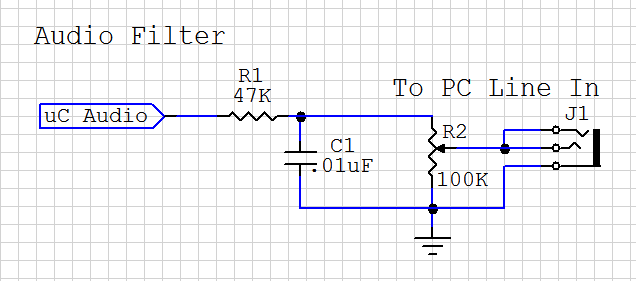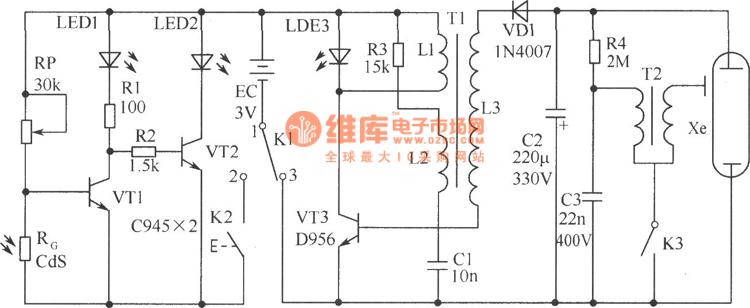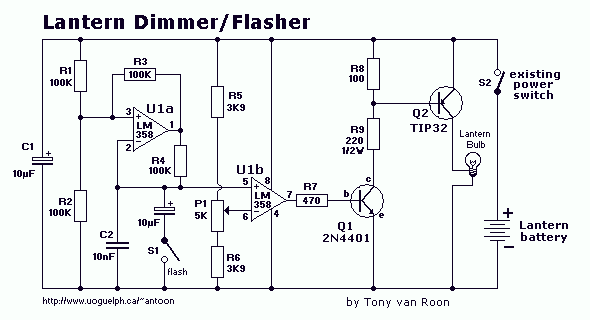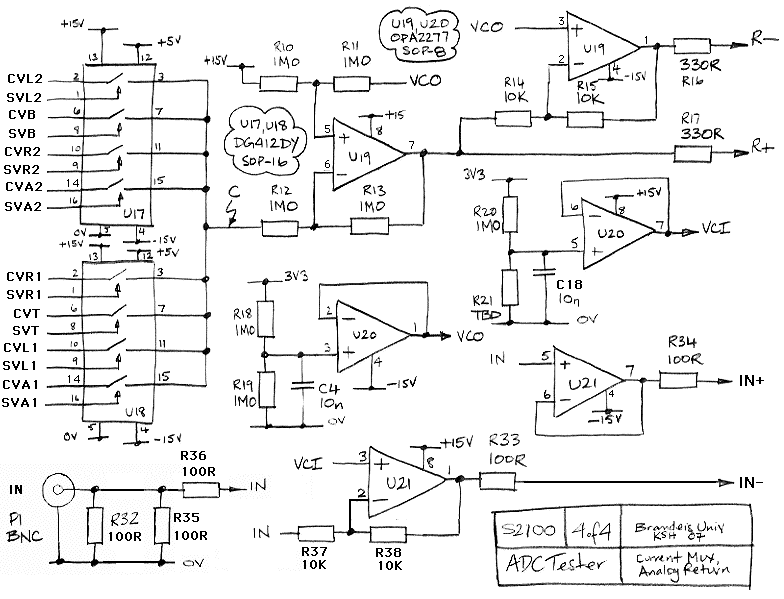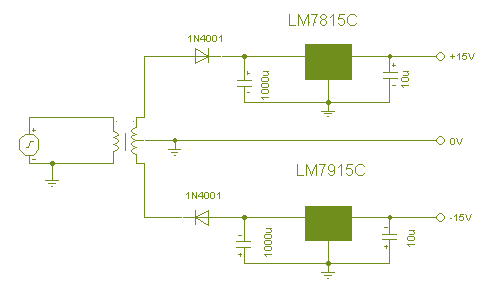
ADUC836 1MIPS 8052 MCU + 62kB Flash + Dual 16-Bit ADC + 12-Bit DAC
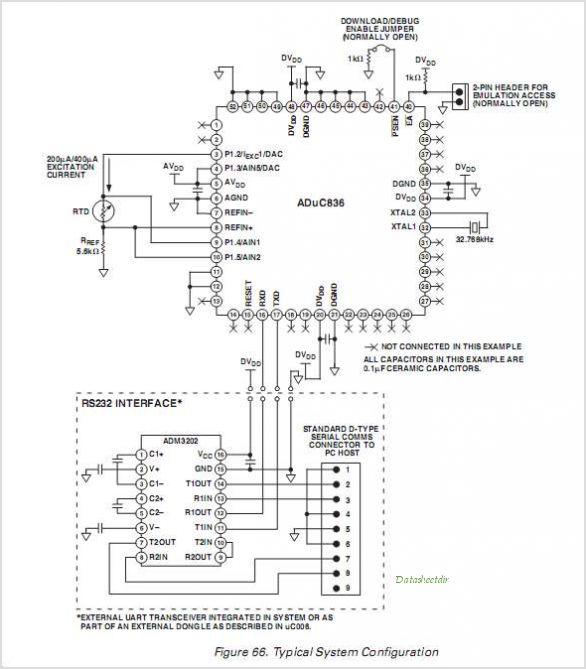
The ADUC841, ADUC842, and ADUC843 are complete smart transducer front ends that integrate a high-performance self-calibrating multichannel ADC, a dual DAC, and an optimized single-cycle 20 MHz 8-bit MCU (compatible with the 8051 instruction set) on a single chip. The ADUC841 and ADUC842 are identical except for the clock oscillator circuit; the ADUC841 is clocked directly from an external crystal up to 20 MHz, whereas the ADUC842 uses a 32 kHz crystal with an on-chip PLL that generates a programmable core clock of up to 16.78 MHz. The ADUC843 is identical to the ADUC842, except that it does not have analog DAC outputs. The microcontroller features an optimized 8052 core, offering up to 20 MIPS peak performance. Three different memory options are available, providing up to 62 kBytes of non-volatile Flash EE program memory, 4 kBytes of non-volatile Flash EE data memory, 256 bytes of RAM, and 2 kBytes of extended RAM, all integrated on-chip. Manufactured by Analog Devices, Inc.
The ADUC841, ADUC842, and ADUC843 are highly integrated devices designed for smart transducer applications, combining various functionalities into a single chip to enhance efficiency and reduce design complexity. The multichannel ADC is capable of self-calibration, ensuring accurate data conversion from analog to digital signals, which is critical in sensor applications. The dual DAC allows for precise analog signal generation, making these devices suitable for applications that require both sensing and control.
The clocking mechanism of the ADUC841 and ADUC842 is a key differentiator. The ADUC841's direct connection to an external crystal oscillator allows for flexibility in clock frequency selection, accommodating a range of applications that may require higher processing speeds. In contrast, the ADUC842's use of a 32 kHz crystal with an on-chip PLL provides a more stable clock source with programmable capabilities, making it ideal for lower-power applications that still demand reasonable performance.
The absence of analog DAC outputs in the ADUC843 suggests its intended use in applications where digital processing and control are prioritized over analog signal generation. This variant may be particularly useful in systems where the DAC functionality is not required or is handled externally.
The integrated 8052 core microcontroller enhances the overall performance of these devices, providing a powerful processing unit capable of executing instructions at a peak performance of 20 MIPS. This efficiency is crucial for real-time processing in transducer applications, where rapid response to changing conditions is necessary.
Memory options available with these devices further augment their versatility. The substantial non-volatile Flash EE program memory allows for the storage of complex algorithms and firmware, while the data memory supports data logging and other memory-intensive tasks. The combination of RAM and extended RAM provides additional flexibility for temporary data storage during processing, making these devices suitable for a wide range of embedded applications.
Overall, the ADUC841, ADUC842, and ADUC843 represent a robust solution for developers seeking to implement smart transducer technology in their designs, offering a rich set of features in a compact form factor.The ADUC841 ADUC842 ADUC843 are complete smart transducer front ends, that integrates a high performance self- calibrating multichannel ADC a dual DAC and an optimized single-cycle 20 MHz 8-bit MCU (8051 instruction set compatible) on a single chip. The ADUC841 and ADUC842 are identical with the exception of the Clock Oscillator circuit; the ADUC8 41 is clocked directly from an external crystal up to 20 MHz whereas the ADUC842 uses a 32 kHz crystal with an on-chip PLL generating a programmable core Clock up to 16. 78 MHz. The ADUC843 is identical to the ADUC842 except that the ADUC843 has no Analog DAC outputs. The Microcontroller is an optimized 8052 core offering up to 20 MIPS peak performance. Three different memory options are available offering up to 62 kBytes of nonvolatile Flash EE program memory.
Four kBytes of nonvolatile Flash EE data memory, 256 bytes RAM, and 2 kBytes of extended RAM are also integrated on-chip. By Analog Devices, Inc. 🔗 External reference
The ADUC841, ADUC842, and ADUC843 are highly integrated devices designed for smart transducer applications, combining various functionalities into a single chip to enhance efficiency and reduce design complexity. The multichannel ADC is capable of self-calibration, ensuring accurate data conversion from analog to digital signals, which is critical in sensor applications. The dual DAC allows for precise analog signal generation, making these devices suitable for applications that require both sensing and control.
The clocking mechanism of the ADUC841 and ADUC842 is a key differentiator. The ADUC841's direct connection to an external crystal oscillator allows for flexibility in clock frequency selection, accommodating a range of applications that may require higher processing speeds. In contrast, the ADUC842's use of a 32 kHz crystal with an on-chip PLL provides a more stable clock source with programmable capabilities, making it ideal for lower-power applications that still demand reasonable performance.
The absence of analog DAC outputs in the ADUC843 suggests its intended use in applications where digital processing and control are prioritized over analog signal generation. This variant may be particularly useful in systems where the DAC functionality is not required or is handled externally.
The integrated 8052 core microcontroller enhances the overall performance of these devices, providing a powerful processing unit capable of executing instructions at a peak performance of 20 MIPS. This efficiency is crucial for real-time processing in transducer applications, where rapid response to changing conditions is necessary.
Memory options available with these devices further augment their versatility. The substantial non-volatile Flash EE program memory allows for the storage of complex algorithms and firmware, while the data memory supports data logging and other memory-intensive tasks. The combination of RAM and extended RAM provides additional flexibility for temporary data storage during processing, making these devices suitable for a wide range of embedded applications.
Overall, the ADUC841, ADUC842, and ADUC843 represent a robust solution for developers seeking to implement smart transducer technology in their designs, offering a rich set of features in a compact form factor.The ADUC841 ADUC842 ADUC843 are complete smart transducer front ends, that integrates a high performance self- calibrating multichannel ADC a dual DAC and an optimized single-cycle 20 MHz 8-bit MCU (8051 instruction set compatible) on a single chip. The ADUC841 and ADUC842 are identical with the exception of the Clock Oscillator circuit; the ADUC8 41 is clocked directly from an external crystal up to 20 MHz whereas the ADUC842 uses a 32 kHz crystal with an on-chip PLL generating a programmable core Clock up to 16. 78 MHz. The ADUC843 is identical to the ADUC842 except that the ADUC843 has no Analog DAC outputs. The Microcontroller is an optimized 8052 core offering up to 20 MIPS peak performance. Three different memory options are available offering up to 62 kBytes of nonvolatile Flash EE program memory.
Four kBytes of nonvolatile Flash EE data memory, 256 bytes RAM, and 2 kBytes of extended RAM are also integrated on-chip. By Analog Devices, Inc. 🔗 External reference
